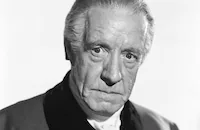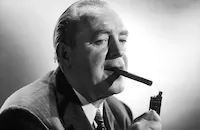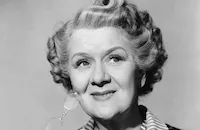Bureau of Missing Persons

Brief Synopsis
Cast & Crew
Roy Del Ruth
Lewis Stone
Pat O'brien
Glenda Farrell
Bette Davis
Allen Jenkins
Film Details
Technical Specs

Synopsis
Police captain Webb is given the department's most difficult missing persons cases to handle. Butch Saunders, one of his staff, has been transferred to Missing Persons because of excessive brutality on his previous assignment. Periodically, his estranged wife Belle makes his life miserable with requests for money. After Saunders successfully finds a missing child prodigy who ran away in an effort to have a normal child's life, he is assigned to find Norma Roberts' missing husband, Therme. Butch is attracted to Norma, in spite of the fact that they are both married, so when Webb tells him that she is really Norma Phillips, and is wanted for the murder of Chicago banker Roberts, Butch doesn't believe the story could be true. Norma talks Butch out of taking her in, but when he returns to her hotel to hear her side of the story, she has disappeared. The police find some of her clothes and her handbag on the dock, but Butch is sure that Norma didn't commit suicide and he stages a fake funeral designed to lure her from hiding. Just as he had hoped, she cannot resist the chance to see her own corpse, and she attends the funeral, as does Roberts. With Butch in close pursuit, Norma runs after Roberts. She tells Butch that when she was Roberts' private secretary, she found out he had an mentally disturbed twin brother. He killed the brother, making it look like he himself was dead in order to escape embezzlement charges. Roberts denies her accusations, but Butch takes him in to the Bureau anyway, where Webb tricks him into admitting the truth. Norma is cleared and Butch discovers that Belle was never divorced from her first husband, so they are free to be with each other.

Director

Roy Del Ruth
Cast

Lewis Stone

Pat O'brien

Glenda Farrell

Bette Davis

Allen Jenkins

Ruth Donnelly

Hugh Herbert

Alan Dinehart

Marjorie Gateson
Tad Alexander

Noel Francis
Wallis Clark
Adrian Morris

Clay Clement

Henry Kolker
George Chandler
Harry Beresford
Crew
Henry Blanke
J. H. Carter
Emmett Emerson
James Gibbons
Ken Green
Robert Haas
Chuck Hansen
Ray Kenney
Barney Mcgill
Robert Presnell
Homer Van Pelt
William Whitley

Photo Collections
Videos
Trailer
Hosted Intro
Film Details
Technical Specs

Articles
Bureau of Missing Persons
Released in 1933 with Pat O'Brien as the headlining star, Bureau of Missing Persons was reissued in 1936 by Warner Bros. with a slight change in the credits; featured player Bette Davis was now the studio's major female draw, so the film's opening titles were refigured to put her in the lead. Fans expecting a Davis starring role may be disappointed that she does not appear until 30 minutes into the film. The movie's structure, though, is episodic by design. It is based on a book, Missing Men, by former police captain John H. Ayres, and details the comings and goings of citizens filing reports with New York City's Bureau of Missing Persons; several cases are under investigation simultaneously. An opening scroll in the film states:
All over the world thousands of persons disappear every day. New York City alone reported over 27,000 missing last year. Why people drop from sight, where they go, and how they are found is the problem of a special and little known department of the police the Bureau of Missing Persons.
Just as there are minor cases and major cases investigated by the Bureau, and sad cases and lighthearted ones, the movie, helmed by prolific director Roy Del Ruth, shifts in tone from melodrama to slapstick farce and back. It also features the gritty look and whirlwind pace typical of Warner BrosFirst National programmers of the early 1930s.
Hardboiled robbery detective Butch Saunders (Pat O'Brien) is suddenly transferred to the Missing Persons division because of his sometimes brutal tactics. Captain Webb (Lewis Stone) is the older-and-wiser head of the Bureau; he warns Saunders that brainwork is required in his new detail, not brawn. Saunders observes some ongoing cases: Detective Musik (Allen Jenkins) is looking for a runaway husband; Detective Conlin (Adrian Morris) is told to follow carrier pigeons to locate a kidnapping victim. In another case, a 12-year old violin prodigy is reported missing before a big concert. Saunders does some uncharacteristically gentle detective work to locate the boy, who has run away from his demanding parents. Norma Roberts (Bette Davis) arrives at the station to report that her husband is missing. Butch, who spends a lot of time avoiding his estranged wife Belle (Glenda Farrell), falls for Norma and takes a keen interest in her case. He finds out that she is wanted for murder by the Chicago police, and when he protects her from arrest, she ducks out on him and tries to fake her own death. Feeling double-crossed, Butch hatches a plan to catch the woman: he gets a body from the morgue and stages a "funeral" for her, assuming that she will show up for her own services.
Bette Davis was happy to work again with Pat O'Brien. They had both acted in Hell's House (1932) the year before, and Davis had become good friends with O'Brien and his wife Eloise. Otherwise, Davis thought this new job was a step down from her recent work, such as the lead role in Robert Florey's Ex-Lady (1933). In Fasten Your Seat Belts: The Passionate Life of Bette Davis, Lawrence J. Quirk quotes from an interview he conducted with Pat O'Brien, who recalled, "in Bureau of Missing Persons, she was... not even 'first among equals' but, shall we say, 'equal among equals,' and it galled her no end. 'This picture is lousy as hell,' she said to me more than once while I tried to kid her into a more mellow mood on the set. I remember that she really blew her top when some stupid fan magazine published an item that she and I were 'that way' about each other and we were both married, and moreover, thought of each other only as friends! Oh, it all got to her all right and I am surprised, in retrospect, that it took her three more years to walk out on the Warners." Quirk also writes that Davis was unhappy with the way she was photographed for the film, that she was "...mightily incensed with photographer Barney McGill, who made her look like two different people in mismatched shots. In some she looked almost matronly at twenty-five yet! and in others seemed eighteen and just out of high school."
The "Follow That Cab!" excitement and humor of Bureau of Missing Persons paid off in excellent box-office returns and good notices from the critics as well. The writer for Motion Picture Herald pretty much summed it up: "The picture moves fast. The dialogue is peppy and there is plenty of exciting action that leads to two surprising climaxes." Bette Davis would get her chance to escape the Warners potboiler formula soon enough; the following year she would star in Of Human Bondage (1934), the breakthrough film of her career.
Producer: Henry Blanke
Director: Roy Del Ruth
Screenplay: Robert Presnell, Story by Carol Bird and John H. Ayres
Cinematography: Barney McGill
Film Editing: James Gibbon
Art Direction: Robert M. Haas
Music: Bernhard Kaun
Cast: Bette Davis (Norma Roberts), Lewis Stone (Captain Webb), Pat O'Brien (Detective Butch Saunders), Allen Jenkins (Detective Joe Musik), Ruth Donnelly (Gwendolyn 'Pete' Harris), Hugh Herbert (Detective Hank Slade), Alan Dinehart (Therme Roberts), Tad Alexander (Caesar Paul), Marjorie Gateson (Mrs. Paul).
BW-73m.
by John M. Miller

Bureau of Missing Persons
Quotes
Trivia
Notes
The film's pre-release title was Missing Persons. According to news items in Daily Variety, Warren William was originally scheduled to play the lead and Charles Wilson was to be a featured player. One-hundred thirty-four extras were used in one day; 200 on another. Correspondence between the AMPP and Warner Bros. executives reveal concern over the portrayal of a ransom demand for a kidnapped person. Modern sources list the following cast: Christian Rub (Apartment house manager); Dewey Robinson (Waterfront diner customer); Hobart Cavanaugh (Mr. Harris); Edward Keane (Hotel manager); Frank Darien; Harry C. Bradley; and Grace Hayle.
















